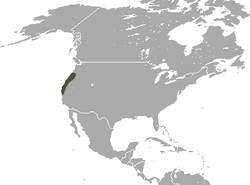| Fog shrew | |
|---|---|
| Scientific classification | |
| Kingdom: | Animalia |
| Phylum: | Chordata |
| Class: | Mammalia |
| Order: | Eulipotyphla |
| Family: | Soricidae |
| Genus: | Sorex |
| Species: | S. sonomae |
| Binomial name | |
| Sorex sonomae Jackson, 1921 | |
 | |
| Fog Shrew range | |
The fog shrew (Sorex sonomae') is a species of mammal in the family Soricidae. It is endemic to northern California and Oregon in the United States. [1]
